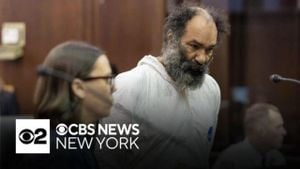The longstanding tensions between Israel and Hezbollah could see a potential pause as both sides edge closer to agreeing on a ceasefire deal, with significant diplomatic efforts spearheading this shift. Recent developments indicate Israel's security cabinet is preparing to approve a ceasefire proposal, largely brokered by the United States and France, which has caught the attention of both local and international observers.
Reports have emerged confirming the expected approval from Israeli Prime Minister Benjamin Netanyahu, signaling this shift could mark the cessation of more than 14 months of conflict, which has led to devastating casualties and widespread destruction across Lebanon. The anticipated cabinet meeting is positioned as pivotal for deciding the future of the violence affecting the region.
Prime Minister Netanyahu’s principle agreement to the proposal has raised hopes for calm, but skeptics remain. Some Israeli officials expressed concerns, warning of missed opportunities for military action against Hezbollah should this ceasefire receive full endorsement. Lawmakers such as Itamar Ben-Gvir, Israel’s far-right National Security Minister, have voiced strong opposition, stating such moves could symbolize weakness against the Iranian-backed group. Indeed, many fear this ceasefire could be fundamentally flawed, enabling Hezbollah to recover its strength.
On the Lebanese side, discussions surrounding the ceasefire have gained momentum under the coordination of influential officials, with Deputy Parliament Speaker Elias Bou Saab noting Hezbollah's tacit support for the negotiations. This support from the militant group, traditionally regarded as antagonistic to Israeli developments, suggests there is some level of consensus for civil cooperation, albeit fragile and tentative.
The proposed ceasefire is reportedly based on United Nations Security Council Resolution 1701, which previously concluded hostilities between Israeli forces and Hezbollah back during the significant 2006 war. This resolution mandates Hezbollah's withdrawal from areas close to the Israeli border and insists on the deployment of the Lebanese army alongside international oversight.
Despite negotiations intensifying, hostilities haven't completely subsided. Israel has continued bombarding suspected Hezbollah strongholds within Beirut and southern suburbs, with airstrikes targeting various locations, resulting in civilian casualties. Reports indicate at least 31 fatalities were recorded on one day alone due to the continued Israeli bombardments. Such escalations fuel fears among Lebanese citizens, many of whom seek security amid the chaos.
Hezbollah’s leadership also confirmed they would not fade quietly if the conflict subsides, hinting their community involvement might continue even post-cessation. Leaders have stated their intentions to aid the resettlement of those who have been displaced during the fighting. This interplay of intentions between the two groups hints at underlying political dynamics at play and the challenges of transitioning from conflict to peace.
Israel's calculated strategy seems aimed at ensuring no renewed threat emerges from the ceasefire. According to Israeli officials, the ceasefire would not mark the end of military engagement, as Israel retains the right to act if Hezbollah appears to violate the terms. The credibility of such assertions hinges on the success of compliance and the peril of renewed provocations under the complex structure of regional power dynamics.
The proposed timeframe for this truce includes one international committee, chaired by the U.S., meant to enforce adherence to the ceasefire. Observers stress the importance of not only sealing agreements but ensuring they hold long-term through concerted diplomatic efforts and ground-level engagement for monitoring compliance.
With uncertainty hanging heavy over both sides, the general public's sentiment remains largely one of cautious optimism mingled with distrust. The anxiety reflects years of complex geopolitical entanglements where ceasefires have previously fallen apart, sometimes even accompanied by spikes of violence. Trust—and the lack thereof—is often the greatest barrier to sustainable peace. Disillusionment persists over the reliability of political leaders to maintain commitments under pressure.
The prospect of returning displaced residents to northern Israel also paints a complicated picture. Many locals have conveyed they feel unsafe returning to what has historically been perceived as volatile territory, highlighting the psychological scars left by prolonged conflict rather than solely physical destruction. Netanyahu's government has attempted to rectify these fears through various means, but grassroots concerns often remain unaddressed, creating gaps between policy and reality.
Simultaneously, Lebanese citizens are grappling with their own uncertainty, just as they walk the tightrope of awaiting the announcement without certainty of peace. Health services are strained as hospitals and healthcare systems work through the fallout of conflict and infrastructure damage. The task of rebuilding will demand considerable international assistance, providing yet another layer amid existing disagreements on sovereignty and control over recovery efforts.
International stakeholders, particularly the United States and France, have been pushing for both sides to recognize the gravity of their shared struggle to emerge from this prolonged bout of hostility. Their interventions are heavily invested not just to find immediate respite but to carve paths for lasting agreements moving forward.
Securing the ceasefire approval could hinge on careful navigation of internal political pressures on the Israeli side, public sentiment, and recent experiences from regional conflicts. Authorities like Benny Gantz have encouraged greater transparency with civilians, emphasizing their right to understand details around potential ceasefire deals. This marks unprecedented dialogue within the Israeli political sphere, where historically, public consciousness surrounding conflicts remained obscured under governmental narratives.
The crafting of any future agreement retains other seemingly peripheral yet significant factors—like economic recovery and the humanitarian plight of those impacted by battle operations. Financial analysts forecast immense economic losses for Lebanon, speculating over $8.5 billion since the war's escalation. Rebuilding community infrastructures and helping the displaced stand as urgent priorities amid unresolved grievances.
Both countries encapsulate the hopes, fears, resentments, and aspirations of their citizens, weary of warfare yet craving the assurance of safety and sustenance. The road from conflict to peace will be difficult to traverse. Feelings of desperation characterize communities striving for resolution, but analysts suggest sustained dialogue offers the best avenues to establish peace—if commitment and trust can be nurtured between long-standing adversaries.
With the clock ticking down to the cabinet meetings across both fronts, the aftermath of these discussions holds the potential to shape the regional power balance and affect countless lives. The fervor of military negotiations serves as both function of the past and foreshadowing of the future, illuminating the path toward resolution or continued conflict.
The anticipation surrounding the ceasefire carries symbolic weight, yet the fragility of the proposed agreement must not be underestimated as discussions continue. Only time will tell if peace can ascend from the rubble of war.



